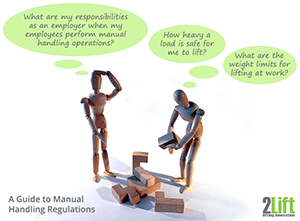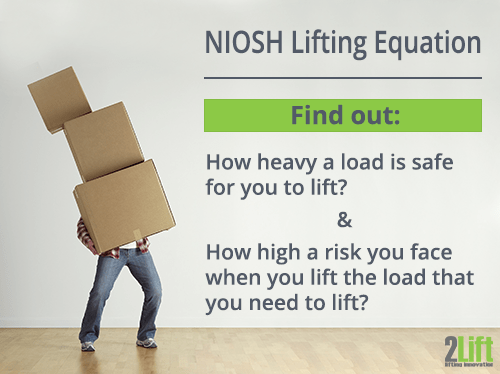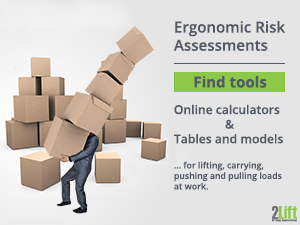The Netherlands
Ergonomic Tools, Risk Assessment Analysis and Manual Handling Regulations in the Netherlands / Holland
If you are an employer in the Netherlands looking for practically orientated guidelines and ergonomic tools to tell you how much you may lift and carry, push and pull at work, things may be a bit more complicated than expected.
Yes, there are officially accepted tools for determining whether or not a manual handling task is healthy or risky. However, these risk assessment tools are mainly intended for occupational health professionals as they are not all that straight forward to apply for a busy employer.
However, we’ve made this article in an attempt to simplify the knowledge for you. Thus this page is for Dutch employers who are in need of information on manual handling legislations in the Netherlands, and who wants the (relatively) quick version.
Here on this page you will get:
- Brief information on how the safety and health authorities and policies work in the Netherlands.
- Links to lifting guidelines and ergonomic tools for risk assessing manual handling operations in the Netherlands.
- Weight limits and other threshold values for lifting in the Netherlands.
The System and Authorities Responsible for Manual Handling in the Netherlands / Holland
Freedom to Customize (to a Certain Degree)
In the Netherlands there is an interesting individualization ‘twist’ in the system of occupational safety and health. You see, in the Netherlands a certain amount of freedom in the policy field of occupational safety and health is granted the employers, who jointly with the employees (or their representatives, e.g. trade unions) must reach an agreement on safety and health working conditions (reference).
Thus the government, the Ministry of Social Affairs and Employment (Ministerie van Sociale Zaken en Werkgelegenheid), is granting the employers (and employees) a certain amount of ‘customization‘, when it comes to how to abide by the law.
Choose a Solution and You Automatically Follow the Law
This safety and health agreement between employer and employee is to be put down in something called a ‘declaration of intent” (which is a fairly new initiative) which applies for the whole industry sector.
This ‘declaration of intent’ then constitutes a form of sector specific buffet (the Arbo Catalogue) of recognized practical solutions and measures that companies within that sector can choose from. And when they have chosen their solution (and implemented it), they will thus automatically have followed the rules of the law which are embedded in that solution.
Employers are not forced to chose from the Arbo Catalogue, they can choose other solutions, but if they do, they must be able to argue that their chosen solution is just as good as the one in the Arbo Catalogue (reference).
To find the legislative rules for occupational safety and health, you need to look into the Working Conditions Act (Arbowet), the Working Conditions Decree (Arbobesluit) or the Working Conditions Regulations (Arboregeling). These legislations are largely based on EU Directives thus making sure that the Netherlands also follow the working condition rules as set by EU.
The Obligatory Health and Safety Officer
In the Netherlands each company must designate a “health and safety officer” who is responsible for integrating the required safety and health demands within the company. If the company has less than 25 employees, this position may be occupied by the director. The health and safety officer is also to help the employer in performing the obligatory Risk Assessment and Evaluation (‘RI&E’) to ensure that health risks at work are eliminated or reduced as much as possible.
The Enforcing Authority: Netherlands Labour Authority
The authority responsible for making sure that companies follow the law is Netherlands Labour Authority (Nederlandse Arbeidsinspectiespectie). They enforce the rules by paying companies visits to see if they are properly complying with the rules. They are also the one supervising the Arbo Catalogue (reference).
Ergonomic Tools, Guidelines and Risk Assessments for the Manual Handling of Loads in the Netherlands / Holland
In the Working Conditions Act, you will not find any threshold limits for how much a person may lift at work. At the request of the Dutch government in 2014, a team of OSH professionals and experts in manual handling and low back pain published a guideline for occupational health professionals with the aim of reducing the risk and occurrence of low back pain.
Weight Limits for Lifting in the Netherlands / Holland
In this guideline (An Evidence-Based Multidisciplinary Practice Guideline to Reduce the Workload due to Lifting for Preventing Work-Related Low Back Pain) it is stated that:
- Loads weighing less than 3 kg does not constitute a low back pain risk if, among other things, the load was lifted less than 10 times per day.
- Loads weighing more than 25 kg does constitute a risk.
When loads weigh between 3-25 kg, a risk assessment should be performed using:
- Either the NIOSH Lifting Equation
- Or the Manual handling Assessment Charts (MAC-tool)

A Quick Word on the NIOSH Lifting Equation
The NIOSH Lifting Equation sets the maximum weight limit one person can lift under optimal circumstances to be 23 kg.
When using the The NIOSH Lifting Equation (which is fairly technical unfortunately) you get a recommended weight limit for a very specific two hand lifting task that is considered safe to lift for 75% of female workers and 90% of male workers.
You can go here if you want to have a go at using the NIOSH Lifting Equation.
The MAC Tool, in Short
The MAC tool sets the maximum weight limit one person can lift under optimal circumstances a bit higher, 25 kg.
Just like what is the case with the NIOSH Lifting Equation, the MAC tool is also fairly technical in nature. But with the MAC tool you go can go a bit broader in types of manual handling operations as there are also risk assessment models for carrying and team handling operations.
Ergonomic Tools for Risk Assessing Manual Handling Tasks in the Netherlands / Holland
The below model (from An Evidence-Based Multidisciplinary Practice Guideline to Reduce the Workload due to Lifting for Preventing Work-Related Low Back Pain) is a flow chart for estimating the risks associated with manual lifting operations.

This ergonomic tool for risk assessing manual handling basically contains four steps:
- Assess the load mass (kg). 3 kg or less generally doesn’t constitute a risk. If more than 3 kg go to step 2. If more than 25 kg, go directly to step 3.
- Assess the lifting characteristics using either the NIOSH Lifting Equation or the MAC tool. If a risk is detected then go to step three.
- Select appropriate measures to reduce the workload on the lower back. Either introduce lifting devices or use the NIOSH Lifting Equation or MAC tool to help with optimizing on parameters that make the lifting healthier and safer, e.g. such as reducing the vertical and horizontal
lifting distance, the load mass, the lifting frequency etc. - Evaluate whether implented measures are used and reduce work load of the lower back.
Assessment Sheet for Determining the Work-Relatedness of Nonspecific Low Back Pain
The above ergonomic tools are inteded to reduce or elimiate the risks of low back pain. If low back pain is already a problem, and you want to find out whether or not it may be work-related, you can use the assessment sheet found in this document: Criteria for determining the work-relatedness of nonspecific low back pain from the Coronel Institute of Occupational Health.
The risk assessment sheet contains questions relating to e.g. the weight of the load, for long the load is handled, if a twisted trunk occures, if there are whole-body vibration levels etc.
At the end you get a total score which equals a percentage of work-relatedness for the back pain.
Guidelines for Pulling and Pushing in the Netherlands / Holland
Just like what is the case for lifting, there are no specific safety limits for the force used in pushing and pulling in Dutch legislation.
In the document Pushing, pulling and applying force in work situations the Committee on the Identification of Workplace Risks (A Health Council of the Netherlands Committee) very cautiously and with many reservations recommends the use of the Mital tables for estimating the risks associated with the pushing and pulling of loads at work.
The Mital tables create a “correlation between applying force, pushing and pulling and the
development of fatigue as a direct health effect.” You’ll find the Mital tables in the appendices (section E) of the above mentioned document.
Online Resources on Manual Handling in the Netherlands / Holland

- Manual lifting at work (an advisory report by Gezonheidsraad (Health Council of the Netherlands))
- Pushing, pulling and applying force in work situations (an advisory report by Gezonheidsraad (Health Council of the Netherlands))
- What Everybody Should Know About RI&E
- An Evidence-Based Multidisciplinary Practice Guideline to Reduce the Workload due to Lifting for Preventing Work-Related Low Back Pain
- Criteria for determining the work-relatedness of nonspecific low back pain
- Manual handling Assessment Charts (MAC-tool)
- The Revised NIOSH Lifting Equation
- A NIOSH Lifting Equation Calculator
Special Copyright Notice
The flow chart model on this page is a reproduction from the document: An Evidence-Based Multidisciplinary Practice Guideline to Reduce the Workload due to Lifting for Preventing Work-Related Low Back Pain. That document is an Open Access article distributed under the Creative Commons Attribution Licence 4.0.
This page also contains public sector information published by the Health and Safety Executive, which is licensed under the Open Government Licence. This notice applies to the illustration for the HSE publication, Manual handling assessment charts (the MAC tool).
Information Disclaimer
We have done our very best to ensure the accuracy and reliability of the information presented on this page. However, we cannot guarantee the correctness of any information (regulations change from time to time, responsibilities change hands, etc.). Thus we cannot accept any responsibility or liability for the accuracy, content, completeness, legality, or reliability of the information provided here.
If, however, you are aware of any outdated or incorrect information on this page, you are very welcome to contact us, so we can bring our page up to date.
Other Pages on Manual Handling Regulations
Country Specific Pages with Ergonomic Guidelines and Risk Assessment Tools
Go to Ergonomics for an overview of rules and regulations worldwide.
Go to our Homepage.




















